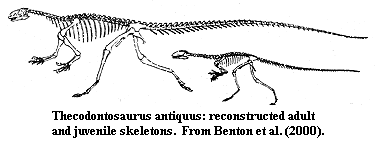 Thecodontosaurus: Thecodontosaurus antiquus Morris, 1843, Thecodontosaurus caducus Yates, 2003a
Thecodontosaurus: Thecodontosaurus antiquus Morris, 1843, Thecodontosaurus caducus Yates, 2003a| Sauropodomorpha | ||
| The Vertebrates | Sauropodomorpha/ "Prosauropods" |
| Vertebrates Home | Vertebrate | Vertebrate |
|
Abbreviated Dendrogram
Dinosauria
├─Ornithischia
└─┬─Theropoda
│
└─○Sauropodomorpha
└─┬─Thecodontosaurus
└─┬─Efraasia
├─○Prosauropoda
│ └─┬─┬─Plateosauridae
│ │ └─┬─Massospondylidae
│ │ └─Yunnanosaurus
│ └─Riojasaurus
└─○"Anchisauria"
├─Anchisaurus
└─┬─Melanorosauridae
└─○Sauropoda
├─Cetiosauridae
└─Neosauropoda
├─○Diplodocomorpha
│ ├─Rebbachisauridae
│ └─Diplodocidae
└─○Macronaria
├─Brachiosauridae
└─○Somphospondylii
├─Euhelopodidae
└─○Titanosauria
├─Nemegtosauridae
└─Titanosauridae
|
Contents
Index |
At the time of this writing (7/00), the unofficial Chief Panjandrum of the Basal Sauropodomorpha is Professor Michael Benton of the University of Bristol. Prof. Benton's particular domain in phylostratigraphic space-time extends out into the sere and barren wilderness of mid-Triassic Dinosauriformes, through the high pass between the Theropoda and Sauropoda, and into the slim, but fertile valley of Upper Triassic and Lower Jurassic Prosauropoda. Recently, forces from Chicago's Field Museum attempted an incursion with prosauropods from the earliest Late Triassic of Madagascar. Flynn et al. (1999). But Flynn's specimens were not securely dated, and Benton immediately countered with Saturnalia, a basal sauropodomorph from the Upper Triassic of Brazil (Langer et al. (1999)) and a redescription of Thecodontosaurus from Triassic Bristol itself. Benton et al. (2000). The latter move was especially dramatic, as the holotype of Thecodontosaurus was destroyed by pin-point Nazi bombing in World War II (undoubtedly the loss of this primitive prosauropod was intended as a stunning blow to British combat paleontology). At the last, Benton was forced to call up his ultimate reserves: casts, paratypes, privately held bits and pieces, and even previously unidentified shards salvaged from the smoking ruins of the Bristol City Museum in 1944.
So, just what does this territory consist of? That's a harder question. In researching this essay, I had set myself the task of trying to determine what Prof. Benton was up to: was there a master hypothesis in back of this recent activity? I am happy to report total failure on that front. I can only state the obvious. Benton and his students have repeatedly made the point that the ancestral sauropodomorph was a remarkably small, gracile creature with a small head and short fore-limbs. Recently, they have suggested that the root of Dinosauria may lie closer to the pterosaurs than previously thought. But the bigger questions remain unresolved.
What is the relationship between the sauropods and prosauropods? Many sauropod workers feel that sauropods are, as originally believed, descended from the prosauropods. That is, traditional Prosauropoda is paraphyletic or, more correctly, that Prosauropoda and Sauropodomorpha are the same. This is consistent with the stratigraphic absence of any sauropod remains until the early Jurassic. However, Benton et al. conclude that this is incorrect and that the prosauropods and sauropods diverged early from a common ancestor. However, they point out that the support for this hypothesis is weak. Furthermore, the analysis in Benton et al. (2000) was performed without the inclusion of the Saturnalia material, which has been named but not yet described in any detail.
Saturnalia might have some strange effects on the results. On the one hand, almost all of the informative characters of Saturnalia are prosauropod. So, for example, the teeth are lanceolate, with coarse serrations oriented at 45 degrees to the vertical, there are three sacral vertebrae, the anterior iliac blade is short and pointed, and the tibia is much shorter than the femur. There is almost nothing distinctive to identify it as related to the Sauropoda. This is not terribly surprising, since by definition, all sauropodomorphs must be referable to one or the other daughter clade.
On the other hand, Saturnalia has some characters so primitive as to raise a few eyebrows. Most notably, the acetabulum (where the hind limb attaches to the pelvis) is not completely open. The open acetabulum is a well-established, in fact possibly the most well-established characteristic of Dinosauria. So this is a little like finding a crocodile with fur. The tibia is strongly S-curved and may be distinctly bent off the mid-line (its hard to tell from the photograph). The ankle joint is said to be "similar to that of Herrerasaurus ... with a broad ascending process of the astragalus." Langer et al. (1999) at 513-14.
The bottom line is that Saturnalia seems to have just about everything it needs to be a prosauropod, but lacks various features apparently shared by all other dinosaurs, or at least by all sauropodomorphs as traditionally understood. If this is all true, one is forced to the tentative conclusion that Sauropodomorpha is polyphyletic. Sauropods and prosauropods may have developed independently from each other. That is, Sauropodomorpha (considered as, say, the last common ancestor of Plateosaurus and Alamosaurus and all of its descendants) may be synonymous with Saurischia or Dinosauria. ATW 000716.
Sauropodomorpha: Saturnalia.
Range: Late Triassic to Late Cretaceous.
Saurischia: Theropoda + * : Thecodontosaurus + (Efraasia (Prosauropoda + Anchisauria)) + Sauropoda.
$ Small skull (< 1/2 length of femur); peg-like teeth with ($) spatulate or lanceolate crowns; $ anterior end of premaxilla and dentary deflected down; $ external nares enlarged; $ 10+ cervical vertebrae; mid and posterior cervical vertebrae longer than dorsals; trunk long relative to hind limb; 3+ sacral vertebrae (with addition of caudals); humerus with deltopectoral crest extending 50+% of bone length; ungual of manus1 much longer than other manual phalanges; acetabulum open (partially closed in Saturnalia); $ anterior process of ileum short and pointed; $ proximal portion of pubes deep; tibia > femur; ascending process of astragalus fits into slot formed by descending process of tibia; $ ascending process of astragalus broad; distal tarsals absent; short feet with large claw on pes 1 (at least as long as other phalanges). Gastroliths frequently present; all or almost all herbivorous. Not a strongly supported clade, as most characters may be secondary to high browsing; may be synonymous with Prosauropoda, or conceivably polyphyletic within Saurischia.
Links: DD: Sauropodomorpha; Lecture 11 - Triassic; Sauropodomorpha; Saurischian Dinosaurs - Enchanted Learning Software; Sauropodomorpha -- The Dinosauricon; Basal Sauropodomorpha; Sauropodomorpha characters, lecture notes); FPDM - Sauropodomorpha Fukui Museum -- still a good site, but not quite what it was); GEOL 104 Lecture 21- Sauropodomorpha- Size matters Tom Holtz' very clear and useful lecture notes); Ficha Sauropodomorpha; ソ・「ヌ・ニク・Sauropodomorpha); Chapter 12 - Clade Sauropodomorpha; Lec 10 - Sauropodomorpha.
ATW030828.
 Thecodontosaurus: Thecodontosaurus antiquus Morris, 1843, Thecodontosaurus caducus Yates, 2003a
Thecodontosaurus: Thecodontosaurus antiquus Morris, 1843, Thecodontosaurus caducus Yates, 2003a
upT of Eur.
Sauropodomorpha : * + (Efraasia (Prosauropoda + Anchisauria))
Small (~2 m), probably bipedal, lightly built; spoon-shaped, saw-edged cheek teeth (or "leaf-shaped with larger serrations on the front and back edges"); teeth slightly recurved [B+]; $ dentary less than half length of mandible [B+]; anterior tip of lower jaw slightly down-curved [B+]; orbits proportionately large; $ long basipterygoid process (as in sauropoda) [B+]; cervical vertebrae with long, low neural arch and anteroposteriorly long neural spine; dorsal vertebrae with pronounced, strongly reinforced, transverse processes [B+]; sacral vertebrae (probably 3) with wide, tightly fused ribs [B+]; long tail with "notably" platycoelous centra [B+]; slim limbs; scapula broad, curved, somewhat platelike [B+]; humerus with prominent deltopectoral crest [B+]; humerus with ends "twisted" by about 60° as in other prosauropods [B+]; ulnae triangular in cross-section [B+]; radius very much reduced [B+]; $ posterior iliac blade squared off [B+]; digits 5/5; metacarpals, esp. I, not very robust; large, clawed thumbs.
 Links: DinoData: Thecodontosauridae; Thecodontosaurus -- The Dinosauricon; Dinosaurs and Evolution 8; Thecodontosaurus German); Thecodontosaurus Italian).
Links: DinoData: Thecodontosauridae; Thecodontosaurus -- The Dinosauricon; Dinosaurs and Evolution 8; Thecodontosaurus German); Thecodontosaurus Italian).
Benton et al. (2000) [B+]
Note: Given its historic and phylogenetic importance -- not to mention the trouble Benton et al. had to go to in order to reconstruct this animal -- Thecodontosaurus deserves much more attention than it is given here. 010914.
Efraasia: Efraasia minor (Huene, 1908)
upT of Germany
Sauropodomorpha ::: * + (Prosauropoda + Anchisauria)
Comments: This unfortunate dinosaur seems to have suffered from something of a personality crisis, having has gone through a number of taxonomic alterations since its discovery. Because the postcrania were associated with Rausiuchian jaws, it was considered to be a very primitive theropod dinosaur, and named Teratosaurus, Much later it was discovered that Teratosaurus was a chimera; a confusion of two different animals whose jumbled remains have been found together, in this case a basal Sauropoda and a Rausiuchian. The name Teratosaurus was retained for the (non dinosaurian) jaws. Having been finally acknowledged as a prosauropod, Efraasia was then identified with the plateosaur Sellosaurus for the next eighteen years or so. Finally, more recent, study has revealed it to be a more primitive sauropodomorph, one that predates the Plateosaur-Sauropod split. But although near the base of the sauropodomorph family tree, it was still a large animal, attaining upto 6 meters in length. Efraasia can be considered a larger and slightly more advanced cousin of Thecodontosaurus, with which it was more or less contemporary.
Links: Taxonomic history of the genus Efraasia Galton, 1973
References: Yates 2003
MAK050117
Late Triassic to Early Jurassic
Sauropodomorpha ::: "Anchisauria" + * : ((Plateosauridae + (Massospondylidae + Yunnanosaurus)) + Riojasaurus). note: despite considerable recent interest, the subdivision of * may amount to no more than "small, medium and large" The taxonomy here is based in part on a simplification of Galton (1990).]
Discussion: Originally considered the most primitive suborder of Sauropodomorpha, the Prosauropoda are now either considered a paraphyletic assemblage of early sauropodamorpha, or, more usually a sister clade to the sauropoda proper. While there is considerable evidence on both sides of the question, but many workers favor the idea that sauropods branched off from basal saurischian stock, rather than being descended from prosauropods. Research by Adam Yates now indicates that both Prosauropods and Sauropods diverged from an early "thecodontiosaurid" ancestor, with Anchisaurus (previously considered a primitive "prosauropod" or basal sauropodamorph) representing the most primitive (but not the earliest) known Sauropod. To avoid confusion with the conventional concept of Sauropods as massive quadrapedal herbivores, I have used the term "Anchisauria" to designate Sauropoda sensu Yates. In view of this rearrangement, some of the following synapomorphies should now be considered plesiomorphic.
The Prosauropoda (now minus the "Thecodontosauridae" and Anchisaurus) are first known from the latest Carnian or early Norian Caturrita Formation of Brazil, if the 2.5 meter long Unaysaurus tolentinoi does indeed turn out to belong here [Leal et al. (2004). They quickly dominated the large plant-eater ecological niche previously filled by dicynodonts and rhynchosaurs up until the Carnian (however Dicynodonts still continued in some areas). Within a few short million years they had grown into very large forms like Plateosaurus, Euskelosaurus, and Riojasaurus, which attained lengths of 6 to 10 metres and weights of up to 2 tonnes, and had become an obligatory quadraped due to large size. Despite the superficial similarity, these animals were only distantly related to the Vulcanodont sauropods (MAK 991008, revised MAK050117)
Characters: $ Articular with a narrow, prong-shaped retroarticular process and a marked medial embayment behind the glenoid in dorsal view; $Distal ends of anterior dorsal neural spines with centrally placed lateral processes; $ Skull about 1/2 length of femur; supposed keratinous beak and fleshy cheek; $ jaw articulation slightly below maxillary teeth (brings teeth to bear serially in slicing, scissor-like motion); $ marked ascending process of maxilla; uniform foliate teeth w coarse marginal serrations; $ distal ischial process triangular; $ distal part of pubes "apron-shaped" (see Lecture 11); manus I w large, pointed ungual; manus IV & V reduced; pes V vestigial. No display structures known. Herbivorous. Tended to increase size and become more quadrupedal. Extremely successful in upT.
Links: Image map; DinoData: Prosauropoda; Lecture 11 - Triassic; Sauropodomorpha -- The Dinosauricon; Literature - Prosauropoda; Project Prosauropod: Discover a Dinosaur with us.; Thecodontosaurus.
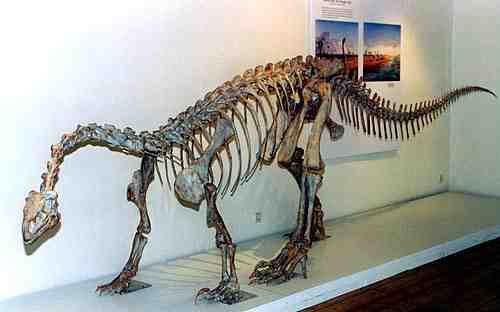 Plateosauridae: Plateosaurus
Plateosauridae: Plateosaurus
upT-lwJ.
Prosauropoda :::: Massospondylidae + Yunnanosaurus) + *.
Medium to large size. As the boundaries of the clade are vague, the following is a description of Plateosaurus. Skull narrow; postorbital portion curved ventrally; nostrils large; jaw articulation well below teeth; teeth regularly replaced; no wear facets on teeth; teeth do not articulate; cervical ribs delicate and oriented post.; 10 caudal, 15 trunk vertebrae; thin gastralia present; 3 sacrals; clavicle present; radius about 50% length of humerus, ulna 75%(?); proximal carpals unknown, perhaps cartilaginous (thus manus not weight-bearing?!); manus I at 45 deg to axis of hand; ant process of ilium pointed; acetabulum perforate, w crest; 4th trochanter very prominent & located in distal half of femur (indicates quadrupedality); tibia length 75% of femur (slow); distal tarsals III & IV disk-like and triangular; all metatarsals of similar thickness; common in Norian Europe.
Notes on Plateosaurus: Galton 2001 2002 has shown that the type specimen of Plateosaurus engelhardti is distinct from the well-known specimens usually placed under that name, and has reinstated Plateosaurus longiceps as the next available name for these animals. Plateosaurus longiceps (= P. trossingensis) is thus a valid species, but P. erlenbergiensis is generically indeterminate. Most specimens (from Halberstadt, Trossingen, Stuttgart-Degerloch, France, Switzerland and Greenland belong to P. longiceps, but the Bavarian ones are P. engelhardti. [synopsis Mortimer 2001]. The less well known P. engelhardti is more heavily built and quadrupedal; P. longiceps is more lightly built and represents most specimens of Plateosaurus, including the famous Trossingen remains [ref. Justin Tweet - Sauropodomorpha]. Adam Yates considers that Galton has not gone far enough in the paper, as the two species share no synapomorphies, and suggests that a generic name needs to be applied to P. longiceps. For the present, we have retained the name Plateosaurus
A third species - Plateosaurus gracilis Huene 1907-08, more usually placed in a separate genus Sellosaurus, is less derived and occurs slightly earlier (Middle Stubensandstein). It was a large animal for its time, 4 to 6 meters long. Galton 2001 suggested Sellosaurus is more than one species- Efraasia diagnostica and Sellosaurus gracilis. [synopsis Mortimer 2001]. According to Yates 2003 Sellosaurus gracilis contains a substantial amount of variation, and it has been found that there are two discrete taxa . The more common one is a generalised (plesiomorphic) species called Efraasia minor; the less common one shares a number of synapomorphies with Plateosaurus engelhardti and is placed in this genus as Plateosaurus gracilis . It represents the beginning of the Plateosaur lineage, a group that evolved parallel to the main sauropod ancestry, and quickly evolved to large size.
Links: Dinosaur Database; Plateosauridae; Plateosaurus; Walking with Dinosaurs - Plateosaurus; The Dinosaur Museum; Plateosaurus engelhardti Meyer, 1837
MAK050117
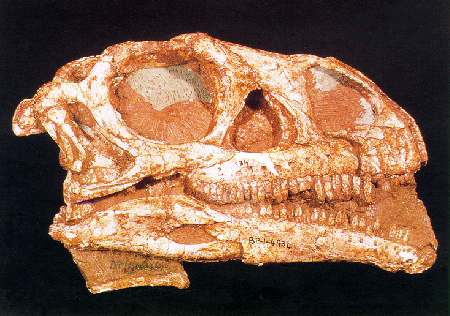 Massospondylidae: Ammosaurus, Gyponyx, Massospondylus.
Massospondylidae: Ammosaurus, Gyponyx, Massospondylus.
Range: Late Triassic and Early Jurassic of South Africa and North America
Phylogeny: Prosauropoda ::::: Yunnanosaurus + *.
Introduction: Length: 4 to 5 metres. This lightly built plateosaur was an abundant member of the south Gondwanaland fauna. As with the east Laurasian Lufeng fauna, large predators seem to be rare or non-existent or perhaps conditions were not suitable for their preservation). There appears to be only one species Massospondylus, which existed unchanged for a considerable period of time. Remains of what may be a second species from the Sinemurian of Arizona indicate that this genus had a very wide distribution, although it is absent from the Lufeng in China, where its place is taken by Lufengosaurus.
Massospondylus is very similiar to Plateosaurus, but is distinguished by its smaller build and somewhat more primitive jaw structure. Peter Galton (1990) places Massospondylus in its own family, the Massospondylidae, while Gregory Paul (1988) takes the contrary position and considers it a species of Plateosaurus. MAK 991008)
Characters: centrally situated and almost vertical dorsal process of the maxilla; jaw articulation only slightly below level of maxillary tooth row; coronoid eminence low; teeth spatulate & coarsely serrated
Links: DinoData Classification Massospondylidae; MASSOSPONDYLIDAE German); Re: Phytodinosauria status; Massospondylids; MASSOSPONDYLIDS; Massospondylus page in The Natural History Museum's Dino Directory; Massospondylus- Enchanted Learning Software (also in Spanish); MASSOSPONDYLUS Portuguese).
References: Galton (1990); Paul (1988). ATW020914.
 Yunnanosaurus: Y. huangi Young 1942.
Yunnanosaurus: Y. huangi Young 1942.
Range: Early Jurassic Hettangian to Pliensbachian) of China
Phylogeny: Prosauropoda ::::: Massospondylidae + *.
Characters: ~7m; self-sharpening, spoon shaped teeth; facultative quadruped? .
Introduction: This genus is still found even at the very end of the Early Jurassic. No Yunnanosaurs are found elsewhere in the world, so there may have been geographical or other environmental barriers to their migration.
Links: DinoData Dinosaurs Y017 YUNNANOSAURUS; Yunnanosaurus -- The Dinosauricon; YUNNANOSAURUS; Yunnanosaurus Spanish); Yahooligans! Science- Dinosaurs; ??? Chinese); Paleontology and Geology Glossary- Y; Re- Phytodinosauria status; ?????? -?- Japanese). ATW030418
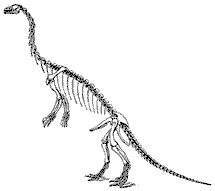 "Anchisauria": = "Sauropoda" sensu Yates
"Anchisauria": = "Sauropoda" sensu Yates
Late Triassic to Late Cretaceous
Sauropodomorpha ::: Prosauropoda + * : Anchisaurus + (Melanorosauridae + Sauropoda)
$ wrinkled tooth enamel; $ Deep U-shaped fossa on ventral surface of the braincase, between the basal tubers.
Note: The term "Anchisauria" is used for this clade, to avoid confusion with "Sauropoda" as conventionally defined (beginning with Antetonitrus)
References: Yates & Kitching (2003); Yates, A. M. (2004).
MAK050117
References: Galton (1990), Yates & Kitching (2003).
Riojasaurus: Riojasaurus
Range: upT of SAm.
Phylogeny: Prosauropoda::: Plateosauridae + *.
Characters: Large size (6 to 10 meters); Obligatory quadrapedal
Comments: I have followed Adam Yates in placement of this genus, but further study may reveal it to go elesewhere
Links: Riojasaurus.
References: Yates & Kitching (2003); (cladogram)
MAK050117
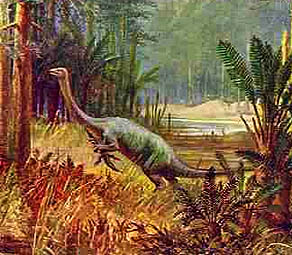 Anchisaurus: A. major Marsh 1889.
Anchisaurus: A. major Marsh 1889.
Early Jurassic of North AmericaAm.
Phylogeny: "Anchisauria" : (Melanorosauridae + Sauropoda) + *.
2-2.5 m & 40-50 kg; relatively large head; numerous blunt, foliate, se , procumbent (?) teeth; short jaw; jaw articulation below upper tooth row (scissor-like bite); large orbit; digits 5/5 with curved manus 1 with large claw; facultatively bipedal(?); traditionally supposed to have been omnivorous, but this is doubtful.
Links: DinoData: Anchisaurus; Anchisaurus -- The Dinosauricon; Internet Familia: Anchisaurus Spanish); justin2; Anchisaurus; Anchisaurus Dutch); Anchisaurus Italian); Prosaurópodos Spanish); The Natural History Museum's Dino Directory (with yet another ludicrous attempt to sell old third-rate art as science -- Paleo velvet Elvises); Anchisaurus Printout - ZoomDinosaurs.com; Triassic Period; PANGEA; Anchisaurus; Anchisaurus Spanish, with lots of information); Paleontology and Geology Glossary; Dinosaurier Interesse.de - Suker- Anchisaurus German); ANCHISAURUS; Dino Land Travels Database Dinosaur State Park- Anchisaurus Model; ANCHISAURUS THE SAUROPOD.
ATW021210.
Melanorosauridae: Melanorosaurus, Camelotia, Blikanosaurus?, - here defined as Melanorosaurus > Antetonitrus 
Range: upT of Afr, SAm, & Engl.
Phylogeny: Anchisauria ::: Sauropoda + *
Characters: Large advanced basal forms. Manus may be better adapted to weight-bearing.
Comments: Riojasaurus is now considered a Prosauropod, and only distantly related to Melanorosaurus. It is not known if the remaining members form a natural group or not. MAK050117
Links: Melanorosauridae;http://www.dinodata.net/Dd/Namelist/Tabr/R029.htm.
checked ATW040114, last modified MAK050117